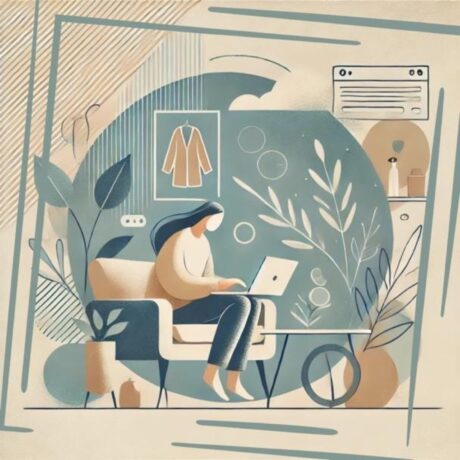Hidden Hands: Homeworkers and their role in the global fashion value chain
Mary Milne from Traidcraft Exchange introduces the women ‘homeworkers’ who play a vital but hidden role in making the clothes we love.
Think of garment workers and what comes to your mind? Lines of young women at sewing machines in Bangladesh, Vietnam or China? Overcrowded factories in sprawling estates?
You’d be right that this is the kind of place where many people work. But there’s another group of workers who play a vital, but often hidden, role in making the clothes we love. And right now, with European and North American fashion brands shutting shops and cancelling orders, these people are facing huge challenges.
Across south Asia, around 50 million women are ‘homeworkers’ – stitching, cutting, doing embroidery, and trimming clothes for the global fashion industry. Homeworkers are the fashion business’s invisible workforce. They work in many garment supply chains, either doing the jobs that need to be finished by hand – cutting off threads, sewing on buttons or doing hand embroidery – or providing additional flexible labour.
Homeworking is a vital cog in complex supply chains, helping suppliers manage the peaks and troughs of demand that come with fast fashion. Too many orders? Put work out to homeworkers.
Bhavna, 32, lives in Delhi but is originally from the rural state of Bihar. She does thread-cutting as well as ‘moti sitara’ (bead embroidery) on different types of clothes. She explains how it works: ‘The contractor brings the work, he is giving it to a ‘madam’ and she gives the work to us.’
It’s likely that this contractor takes work from a supplier, who maybe takes work from another bigger supplier, who may be contracted by a national or international brand. And the brands, although they should be aware that homeworking is likely to happen in their supply chains, just turn a blind eye.
For most women like Bhavna, homeworking is the only way to earn money while looking after young children. Factory work is much better paid – but homeworking is flexible around caring responsibilities, and can be more socially acceptable for women from socially conservative families.
Ankita explains: ‘I can’t work in a factory, as I can’t leave my kids unattended…. I prefer to work from home and look after my kids. Additionally, my husband doesn’t like it if I work outside.’
Despite their crucial role in garment supply chains, homeworkers are denied their rights as workers. So that means no sick pay, no maternity pay, no entitlement to a pension or other social security and no guarantee of work.
Homeworkers are paid at a piece rate per item which is often just a few pennies. Some women interviewed by Traidcraft Exchange were earning the equivalent of just 30 pence for 8 hours work.
‘We get up to 6 rupees (6 pence) per piece, but it depends on the piece. Sometimes it is 2 rupees, 5 rupees, depending on the hard work. But the right payment for our hard work goes to the contractor and other middlemen, not us,’ says Amita, 36.
Amita hasn’t been able to work for six months because she developed pain in her hands and back. So the family has had to rely on her husband’s earnings alone.
Several of the workers told us that they are only paid around twice a year, when the contractor is paid. Bhavna said that she has to wait for payment which is usually made around the time of the festivals of Holi and Diwali. ‘I take some money in advance when I need to, and she deducts this money when she is paying me at the time of festival,’ Bhavna said. This pattern of payments puts workers at risk of indebtedness and means they have to continue working until they are paid. It makes them less likely to complain about pay rates or move to a different contractor.
Ankita told us that she had tried to ask her contractor for more pay: ‘We asked her to understand how much hard work we have to do, to bring the piece and then return it. We have to bring it again if it needs to be altered, and have to also go back to return the finished piece. So we asked them to increase the rate, but they don’t do it.’
Located at the periphery of the supply chain, homeworkers have to take what they are given. They are in no position to walk away.
Work is never guaranteed, it depends on the needs of the garment factories and ultimately the orders from brands. As Kanchan says, ‘There is no set pattern, some months it comes more and some months it doesn’t.’
With the whole garment industry in lockdown, homeworkers like Bhavna, Ankita, Amita and Kanchan are some of the most vulnerable people in the whole system. Work has just stopped, and it is very unlikely that any benefits or compensation agreed between brands and suppliers will find its way to their families.
We’re connected to these women in ways most of us never realise – because they help make many of the products we buy. Much as many of the brands turn a blind eye, or even deny that homeworking happens in their supply chains, it is part of the system of fast fashion. Millions of families depend on homeworking and a blanket ban is not the solution. But we think it’s time to honour homeworkers, celebrate their contribution – and above all, give them the same rights as other workers.
*Names have been changed to protect the identities of the women interviewed. Traidcraft Exchange is currently working with representatives of homeworkers in India, Pakistan and Nepal and with European brands and multi-stakeholder initiatives to map supply chains down to the homeworker level. The programme will help brands introduce simple systems that document homeworkers’ contribution and wages, and develop action plans that drive transparency, best practices and improve working conditions. Image Credit: Traidcraft Exchange/Priyanka Chharia








